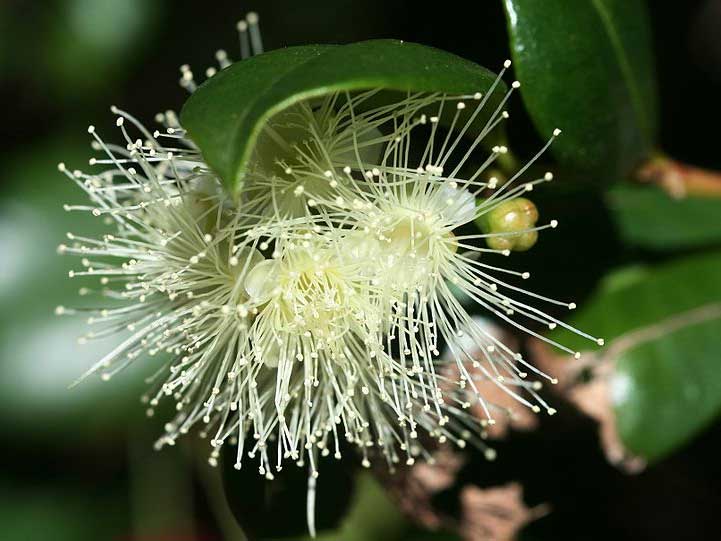
Syzygium australe (*)
Classification System: APG IV
Superregnum: Eukaryota
Regnum: Plantae
Cladus: Angiosperms
Cladus: Eudicots
Cladus: Core eudicots
Cladus: Rosids
Cladus: Eurosids II
Ordo: Myrtales
Familia: Myrtaceae
Subfamilia: Myrtoideae
Tribus: Syzygieae
Genus: Syzygium
Species: Syzygium australe
Name
Syzygium australe (J.C.Wendl. ex Link) B.Hyland, Austral. J. Bot. Suppl. 9: 55.. 1983.
Synonyms
Basionym
Eugenia australis J.C.Wendl. ex Link, Enumeratio Plantarum Horti Regii Berolinesis 2. 28. 1822.
Homotypic
Jambosa australis (J.C.Wendl. ex Link) DC., Prodr. (de Candolle) 3: 287. 1828.
Myrtus australis (J.C.Wendl. ex Link) Spreng., Systema Vegetabilium 2. 1825.
Heterotypic
Eugenia myrtifolia Sims, Bot. Mag. 48: t. 2230. 1821.
Eugenia simmondsiae F.M.Bailey, Queensl. Agric. Journ. 23(6). 297. 1909.
Jambosa myrtifolia (Sims) Heynh., Nomencl. Bot. Hort. 2: 428. 1841.
Jambosa myrtifolia (Sims) Nied., Nat. Pflanzenfam. [Engler & Prantl] 3. 7. 84. 1893, comb. superfl.
Jambosa thozetiana F.Muell., Fragm. (Mueller) 1(10): 225. 1859.
References
Australian Plant Name Index (APNI). Integrated Botanical Information System (IBIS). Australian National Botanic Gardens & Australian National Herbarium. 2009 Aug 23 [1].
Hyland, 1983 [see pp. 55-56, Fig. 52, Map 15]
Vernacular names
English: Brush Cherry, Creek Satinash, Scrub Cherry, Watergum, Creek Lillipilli, Creek Lilly pilly, Magenta Lilly pilly, Creek Cherry
Syzygium australe, with many common names that include brush cherry,[1] scrub cherry,[1] creek lilly-pilly,[1] creek satinash,[1] and watergum,[1] is a rainforest tree native to eastern Australia. It can attain a height of up to 35 m with a trunk diameter of 60 cm. In cultivation, this species is usually a small to medium-sized tree with a maximum height of only 18m.[3]
Description
The leaves are opposite, simple, lanceolate from 4–8 cm long. Flowers are white and in clusters. The pink, elongated, edible fruits range from a size of 1.5 to 2.3 centimeters long, and ripen mainly in summer and autumn. The fruit surrounds a small, circular seed. The flavour of the fruit is described as having a refreshing taste, and have a small hint of sourness to them.[4][5]
This species is commonly confused with magenta cherry and the blue lilly pilly. However, the brush cherry has a paler trunk.
Distribution
The species occurs in coastal regions in Queensland and New South Wales, northwards from Batemans Bay.[6]
Germination
Syzygium australe usually takes about 6 weeks to germinate depending on the temperature and the soil moisture. Ideal temperatures for Brush cherry germination is 18-26 degrees Celsius (65-80 F). The soil needs to be moist, but not waterlogged as this can rot the seed. For successful germination, remove all the flesh from the seed. Plant the seeds about half an inch deep in soil. If planting in a pot, make sure it has good drainage.[7]
Cultivation and Uses
Brush cherry is commonly cultivated in gardens in Eastern Australia, mostly as shorter, shrub-like cultivars such as "Aussie Boomer", "Aussie Compact", "Birdsville", "Bush Christmas", "Minipilly" and "Tiny Trev".[3] These are especially popular as hedges.
The pleasantly sour fruit are also eaten fresh or cooked. The fruit can be used to make jams and jellies.
This species has been adopted by Coffs Harbour City Council as the City's floral emblem.[3]
Brush cherry is used as a subject for bonsai.[3]
Mature brush cherry at Mount Keira, Illawarra, Australia
Mature brush cherry at Watagans National Park, Australia
Cross-section of fruit showing the circular seed.
References
"Syzygium australe". Australian Plant Name Index (APNI), IBIS database. Centre for Plant Biodiversity Research, Australian Government. Retrieved 3 August 2013.
"The Plant List: A Working List of All Plant Species". Retrieved 17 January 2014.
Wrigley, John W.; Fagg, Murray A. (2003). Australian native plants: cultivation, use in landscaping and propagation (Fifth ed.). Australia: Reed New Holland. p. 696. ISBN 1-876334-90-8.
Floyd, A.G., Rainforest Trees of Mainland South-eastern Australia, Inkata Press 1989, ISBN 0-909605-57-2
Low, Tim (1991). Wild food plants of Australia. Level 13, 201 Elizabeth Street, Sydney, NSW 2000, Australia: HarperCollins Publishers. p. 76. ISBN 0-207-16930-6.
Wilson. Peter G. "New South Wales Flora Online: Syzygium australe". Royal Botanic Gardens & Domain Trust, Sydney, Australia.
"Planting Methods for Lilly Pilly". hunker.
Retrieved from "http://en.wikipedia.org/"
All text is available under the terms of the GNU Free Documentation License

